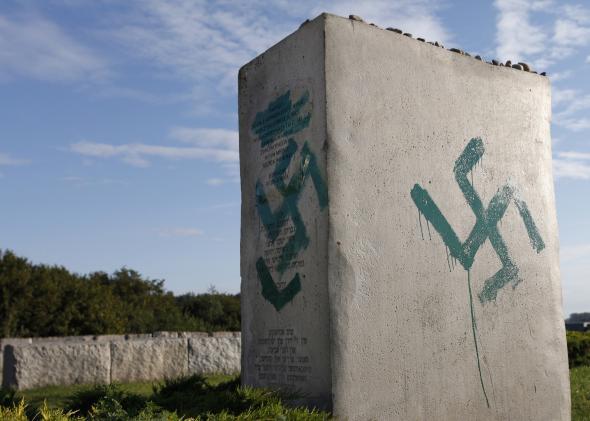Yesterday I wrote about the exaggeration and exploitation of anti-Semitism. I discussed three cases: 1) the shooting of three people at two Jewish facilities in Kansas, 2) the campaign against a U.N. official for alleged anti-Jewish bias, and 3) an anti-Semitic flyer in Ukraine. With regard to the Kansas shooting, I cited data from the FBI and the Anti-Defamation League showing that anti-Semitic hate crimes have been declining in the U.S. I contrasted these data with a statement from the European Jewish Congress, which said that the shooting “demonstrates that neo-Nazis and anti-Semites are becoming emboldened” and that “we are witnessing an intolerable rise in neo-Nazi violence on a global scale.”
In comments on the article, two readers criticized this juxtaposition. “The European Jewish Congress is talking about incidence of Anti-Semitism around the world,” wrote Lon. “Falling rates in the US don’t actually contradict what they are quoted as saying.” Another commenter, Emily, added that “using US hate crime measures to infer anything about worldwide attitudes towards Jews or anti-Jewish violence is naïve.”
Lon and Emily are right. I shouldn’t have framed the FBI and ADL data as a rebuttal to the EJC. What the FBI and ADL data show is that anti-Semitic hate crimes in the U.S. have been declining and that the Kansas shooting is an outlier. These data don’t address trends in Europe or elsewhere. And the data in Europe are much more complicated.
There’s no reliable index of anti-Semitic incidents worldwide, because each country defines or compiles these incidents differently. The next best thing is this table, published six months ago by the European Union Agency for Fundamental Rights. It shows trends in indices used by different countries during the previous decade:
Over the 10-year period, the indices in France and Germany ended up in a lower range than where they began. The index in Sweden ended up in a higher range. The indices in Austria, Belgium, Ireland, and Slovakia went up and down. The index in the Czech Republic peaked in 2009 and has been falling since.
Using the terrific Web site of the Coordination Forum for Countering Antisemitism, I went back through all the available national reports on anti-Semitic incidents that have been published this year. Here’s a 10-year graph from Canada, showing an increase from 2005 to 2010, albeit with a slight drop last year:
Here’s a five-year chart from the U.K., more suggestive of decline:
Here’s a similar table from Russia, again suggesting a negative trend line. The top row, translated to English, counts victims of hate crimes (presumably all these crimes were anti-Semitic, since the report is titled, “Manifestations of anti-Semitism”). The bottom row counts victims of clearly anti-Semitic attacks.
It’s best to look at changes over a decade or more. Here, for instance, are the only decade-long numbers I’ve seen from the Netherlands (published in the EAFR report):
On balance, it appears to me that more of these countries show declines than show increases. But that’s subject to statistical argument, and it doesn’t change the fact that the trends in Europe aren’t as clear as the trend in the U.S. As the Ukraine and U.N. cases illustrate, anti-Semitism is sometimes hyped or manufactured for political advantage. And in the U.S., the Kansas shooting is an outlier. But in some countries, the rate of anti-Semitic incidents is holding steady or even increasing. Each country is different.
